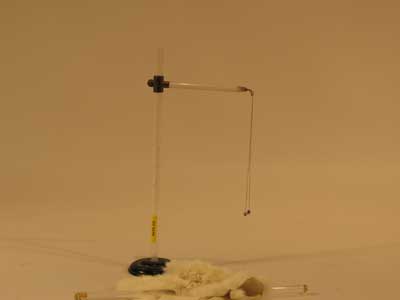5A00.00 Flamingo and Bag
Rub flamingo with bag; flamingo charges negative.
That flamingo is charged can be proved by bringing it near an
electroscope.
This demonstration is used to show that even everyday objects (that is,
objects of a type not found solely in physics class) can be
charged.
|
 |
5A10.20 Electrophorus
Electrophorus = "charge-bearer".
Place flat acrylic plate on grounded conducting plane (not shown).
Rub plate with fur to charge it negative.
Place electrophorus on plate, momentarily ground top surface of
electrophorus.
Remove electrophorus. Potential of electrophorus may be as high
as 30 kV.
More info:
http://www.ece.rochester.edu/~jones/demos/electrophorus.html
|
 |
5A20.10 Stirrup
Rub clear rod with cat fur. Clear rod charges positive.
Place it in stirrup (which hangs from non-conducting silk thread) as
shown.
Rub black rod with cat fur. Black rod charges negative.
Hold black rod near clear rod. The two rods attract.
|
 |
5A20.20 Two pith balls
Rub rod with cat fur to charge rod.
Bring rod near two pith balls (pith balls hang from insulating thread).
At first balls are attracted to rod.
When they touch, charge transfers. Now they are repelled by rod,
and by each other.
Pith Ball Pitfalls:
Pith balls act as imperfectly conducting spheres. Charge on the
surface may or may not be free to move. Induction effects may be
important to pith ball dynamics.
|
 |
Cylinder and balls, 5A20.23
Rub rod with cat fur and touch rod to cylinder.
Electric field around cylinder approximates field due to finite line
charge on cylinder axis.
Pith balls show presence of electric field surrounding charged
conductor.
|
 |
5A22.10 Electrometer
Rub rod with fur, touch rod to knob on top of electrometer.
Full-scale needle deflection 1500V (easy to achieve with rod and fur).
|
 |
5A22.10 Electroscope
Rub rod with fur, touch rod to knob on top of electroscope,
leaves diverge indicating non-zero charge on electroscope.
Rub same rod with fur, bring it near but not touching knob.
Leaves diverge further.
Rub the other rod with the fur, and bring it near but not
touching. Leaves droop.
This indicates there are two types of charge, and that that which
attracts one repels the other.
|
 |
5A40.40 Water Stream
Fill sawed-off milk carton with water and add several drops of green
food coloring to make water more visible.
Open valve to let a stream of water run out (into catch basin).
Rub rod with fur and bring it near stream of water.
Stream of water attracted toward the rod (see picture).
|
 |
5A50.10 Wimshurst generator
Turn crank on Wimshurst generator (crank cannot be seen; it is on
reverse side of disk) so that disk spins.
Brushes which contact the spinning disk are connected to electrodes
(small silver balls in top center) in such a way that small asymmetries
in charge on electrodes are amplified.
1" spark can easily be drawn, indicating potential difference of about
30kV between electrodes.
|
 |
5A50.15 Toepler-Holtz generator
Turn crank on Toepler Holtz generator.
It is similar to Wimshurst generator in that brushes which contact
spinning disk are connected to electrodes in such a way that small
asymmetries of charge on electrodes are amplified.
It differs from Wimshurst in that electrodes are connected to Leyden
jars so that spark, when it occurs, carries a larger current.
SAFETY: The spark from a Toepler-Holst can be painful and cause
injury. Do not touch or put body parts close to the electrodes
until you are sure they are grounded. To ground the electrodes,
put one hand in your pocket and use the other hand to grasp one of the
insulating handles on the ends of the electrodes to bring them
together.
|
 |
5A50.30 Van de Graaff Generator
God's gift to physics outreach. Turn on power; big silver
electrode charges positive (true for the current model, from Cenco;
this depends on materials used for belt and rollers).
When working well spark jumps to small electrode, indicating potential
difference of about 100kV, every 0.5 seconds or so.
Wooden rod with nail on end is connected to ground and can be used to
remove charge.
With machine off:
Remove small electrode, and ask volunteer to stand on plastic stool and
place hand on large electrode.
Turn machine on.
Volunteeer's hair should stand up straight.
Ground large electrode.
Turn off machine.
Note: The spark from this machine can sting but injury is
unlikely because the capacitance of the big silver electrode is not
that large.
|
 |
|
|












